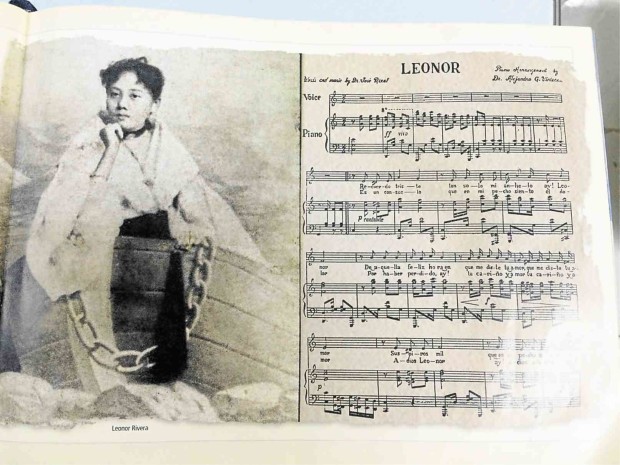Rizal’s song immortalizes affair with Leonor Rivera

LOVE SONG A music sheet shows the piano arrangement to national hero Jose Rizal’s song, “Leonor,” to Leonor Rivera, in this image reproduction of two pages in the coffee-table book, “Dagupan: The Story of a Coastal City and Dagupan Bangus.”
DAGUPAN CITY—It was in Dagupan where the love story of national hero Dr. Jose Rizal and Leonor Rivera blossomed; it was also where their romance met a heart-wrenching end.
Only a few historical records—and a song simply titled “Leonor,” which Rizal composed and sang—serve as reminders that Rizal and Rivera were not destined to be together.
The song, written in Spanish, shows another facet of Rizal’s intellectual prowess. One line went: “Recuerdo triste tan solo mi anhelo ay! Leonor (Always remember my sad longing for you, Leonor).”
The piano accompaniment was arranged by Dr. Alejandro Venteres, a member of the Venteres family who were the Riveras’ landlords in Dagupan. A copy of the piece, including the lyrics and melody, is contained in the coffee-table book, “Dagupan: The Story of a Coastal City and Dagupan Bangus.”
Venteres wrote: “From Rizal’s hometown, he would travel to Dagupan on a type of boat called paraw. The railroad was still under construction. Knowing that Rizal was going to Europe, Leonor planned a party for him. She held it on the pretext of a raffle game. Rizal was so elated he was inspired to write a farewell poem with music. Rizal himself sang it to the accompaniment of Lazaro de Ocampo, alias Darog.”
Article continues after this advertisementSinging in the streets
Article continues after this advertisement
“The song became so popular that many were heard singing it in the streets and during social gatherings. The moment they saw Leonor, the children would sing the song,” he recalled.
According to the book, Rizal met Leonor when he was a student of the University of Santo Tomas and was a boarder at her father’s house. “They kept their feelings to themselves, writing love notes to each other using pen names. Leonor signed her letters, ‘Taimis,’” it said.
When Rizal left for Spain to pursue his medical studies, he bade his sweetheart goodbye, promising to marry her upon his return. He was 21, she was 15.
But like telenovelas, their love story was a bitter drama.
While Rizal was in Europe, Rivera’s parents learned about their romance. “Her mother was particularly worried for her young daughter because, by then, Rizal was already a controversial figure for being in the forefront of the reform movement in Europe,” the book said.
No replies to letters
Rizal returned to the Philippines after the publication of “Noli Me Tangere” in 1887 to look into an agrarian problem involving his family and the rest of the people of Calamba, his hometown, in Laguna. He also wanted to know why Rivera had not been answering his letters.
Rivera’s parents—Antonio and Silvestra, both from Camiling, Tarlac province—settled in Dagupan in the later 1880s, taking Leonor with them. They were engaged in the textile business, with a stall at the public market.
The Manila-Dagupan railway was being also being constructed then. A dashing English engineer, Charles Henry Kipping, who was a supervisor of the railway project, met Leonor and her parents at a party, Venteres said.
“Kipping was infatuated with the young Leonor, that frail, beautiful girl, tender as the budding flower with kindly wistful eyes,” he wrote.
Intercepted
Rivera’s mother saw the special attention Kipping gave her daughter. She encouraged the courtship as she wanted to break up Leonor’s relationship with Rizal.
She bribed the town’s postmaster to intercept Rizal’s letters, but Leonor discovered the ruse. Though Leonor confronted her mother, she succumbed to family pressure and wed Kipping at St. John’s Church of Dagupan on June 17, 1891.
The Book of Marriage or “Libro de Casmientos” of the Lingayen-Dagupan Archdiocese lists Leonor’s husband as Don Carlos Enrique Kipping. They had one child, a boy named Carlos.
Rivera was unhappy and said in a letter that she would not live long. She died on Aug. 28, 1893, at the young age of 26.
The love of her life, Rizal, died on Dec. 30, 1896. He was 35.